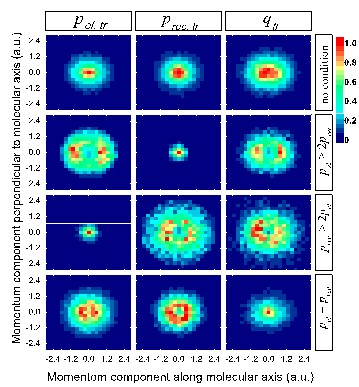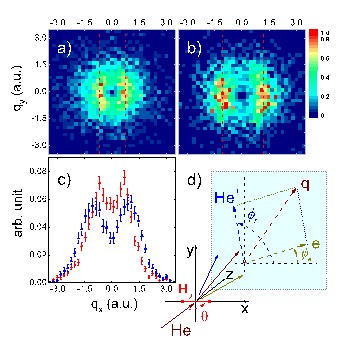Young double slit interference is a clear manifestation of the wave character of light and can experimentally easily be demonstrated. An analogous "double slit" experiment to prove the wave nature of charged particles, postulated by DeBroglie in 1925, is not as straight forward because of the typically tiny DeBroglie wave-lengths of particles with non-zero rest mass.
In the collaboration of Institute of Modern physics Chinese Academy of Sciences (IMP) and Max Planck Institute for Nuclear Physics, researchers have investigated the two-center interferences at atomic-scale in a collision between H2+ projectile ions and helium target atom using kinematically complete technique. In the process the H2+ projectile ions are used as a double slit, the helium atom is singly ionized and simultaneously the molecular hydrogen ion is dissociated. Interference effects are observed both in the individual spectra of target fragments (the electron and the recoil) and the spectra of the target atom (He) as a whole with respect to different collision mechanisms (Fig. 1).
In the perturbative description, different first- and higher-order terms contribute to the cross section presented in the spectra, a correlated first-order mechanism, and an independent higher-order process. This results in a blurring of oscillating patterns in the integrated cross sections (the first row of the figure).
However, in spite of this rather complex collision system, the two contributing mechanisms can be separated by choosing appropriate kinematic conditions revealing clear interference structures. The observed features agree well with the predictions of two center interference effects in first (the second row of the figure) and second order (the third row of the figure) perturbation theory.
Fig.2 shows the relationship between the interval of interference fringes and the distances between two slits (the internuclear distance). As the internuclear distance increases, the interval becomes smaller, and vice versa, which is the inherent Young's double-slit characteristic.
The work has been published in Physical Review Letters, and recommended as a highlighted article.

Fig.1 Two-dimensional momentum distributions in the xy plane of the molecular frame. Columns from left to right: electron momentum (pel,tr), recoil-ion momentum (prec,tr), and momentum transferred from the molecular ion to the target atom (qtr). (Image by IMP)

Fig.2 The interval of the interference fringes as a function of the internuclear distances: a) with large internuclear distance; b) with small internuclear distance. c) the definition of the molecular frame. (Image by IMP)

